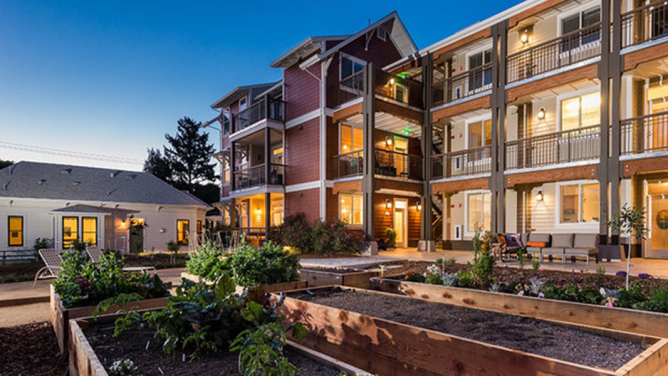The “time bomb” of inaccessible housing
In 2018, 7.3% of the European population was unable to maintain an adequate temperature in their homes. In France, the 10% of the poorest households spend 40% of their income on housing… In this context, access to quality housing has become a major issue. While rising prices and the lack of available housing are often pointed out, local authorities, construction professionals and developers are struggling to reverse the trend.
To better understand the causes and explore the solutions related to the subject of accessible and quality housing, Leonard invited Catherine Sabbah, general delegate of the Institut des Hautes Etudes pour l’Action dans le Logement (IDHEAL) and Patricia Muller, in charge of the brand development department at VINCI Construction France, in particular Primméa, whose ambition is to develop a qualitative and affordable housing offer. They share their views and expertise.

In France, more than 4 million people are unhoused (or poorly housed). How did this come about?
Catherine Sabbah: I recently found a book dating from 1965 entitled “Peut-on loger les français? (Can we house the French people) At the time, it asked questions that are still valid today. Why are there people sleeping outside? Why are there poorly housed people in a rich country? Inequalities in access to housing are very high today, and for a large part of the population, housing is simply too expensive. For many years it has been treated as a consumer product rather than a necessity. Lack of attention to needs and supply-side policy has led to the construction of sometimes unnecessary housing at prices that were not affordable. The industry developed from a financial rather than a social point of view.
Patricia Muller: It is true that the existing supply is not always in line with the needs. While housing is by nature a place to live, the last person you think about when you design, draw or build a house is often the occupant. We are more inclined to adopt the position of a passer-by who will look at the building from the outside and appreciate, or not, its aesthetics. I would add that the process of designing, producing and marketing a building is long and complicated. It is an addition of different technicalities, in a value chain which is not always fluid. Between the promoters, the departments that examine the applications for building permits, the architect, the design offices, the engineers, the builders and those who market the buildings, the process is long and the contributors are numerous, which contributes to making it expensive.
What are the technical, political, financial and social levers available to reverse the trend and promote access to housing?
Catherine Sabbah: In France, there is a housing policy, with a market shock absorber which is social housing, to which 70% of French people are entitled. Producing more social housing is therefore a first solution. Another public policy would be to limit the impact of the price of land on the final price of housing, i.e. to limit the price of land when it is public land. A tax on capital gains above a certain amount could also limit the rise in prices.
Among the technical possibilities, I am thinking of prefabrication. It is now very qualitative and allows for a reduction in time and site nuisances. Generally speaking, we are in a system that suffers from extremely strong habits and the fact that all the players benefit from the continuous rise in prices. Even those who are not yet owners project themselves into the status of owner, and imagine making a surplus value. The system benefits all the intermediaries…
Patricia Muller: … except for those who never become owners. I think that one of the first ways forward is to strengthen the agreements between private and public players. For elected officials, the desire to realise large capital gains on available land is incompatible with the ambition to retain the most vulnerable populations. Private actors must also undoubtedly rethink their way of thinking and innovate to respond differently. Today, each apartment building is almost a prototype. There is little capitalisation from one programme to the next and this is not systematised as it could be in a permanent progress-type approach. It is from this observation that we imagined, in order to design our Primméa affordable housing offer, to develop models and to start from these models in order to improve them for each new programme in an optimised and significantly shortened design and production process. We defined these models with a representative panel of first-time buyers. Combined with the development of technical innovations (such as pre-assembled off-site technical ducts) or sales innovations, this has enabled us to significantly reduce our production and marketing times and costs. Thanks to this approach, we have already delivered 13 Primméa programmes in France, which we have sold on average 20% below the local market for equivalent services and locations.
Is it possible to reconcile accessibility and quality? And how?
Catherine Sabbah: The argument consists of saying “if we do bigger or better it will be more expensive”. But if we think in industrial terms, we see that we are faced with a product that is increasingly expensive and of poorer quality. The inhabitants are not given a choice and are subjected to the offer. The question of the responsibility of both private and public actors must be at the centre of the debate. There is a responsibility in terms of safety, but also a social responsibility. Perhaps we take too lightly the job of the person who builds a piece of the city, and who is going to place it for 50 or 100 years in the landscape.
Patricia Muller: In construction, there are what are known as “reserves”, which are defects noted by clients on delivery that force the construction teams to intervene again later. A property is one of the few products today that is delivered to customers without reaching “0 defects”. I am not sure that it can continue to work in this way for years. With Primméa, by positioning ourselves at 20% below the market price, we are condemned to the final quality of what we deliver to our clients. If you put a product on the market that is cheaper but not of quality, it has no chance of surviving. Paradoxically, it is by lowering prices that we can better control quality, because we challenge the way we manage our value chain and optimise it from upstream to downstream to “get it right first time”.
What are the aspirations or, more simply, the needs of the inhabitants today, particularly following the COVID-19 crisis?
Catherine Sabbah: Needs are changing, and they have changed in a major way with COVID-19. Sent home 23 hours a day for 55 days, we became aware of certain dysfunctions. In a department like Seine Saint-Denis (close to Paris), over-occupation simply facilitates the circulation of the virus. The question of the organisation of the home when one has to work, play or go to school there is also important. I refer to the study carried out by IDHEAL entitled “Nos logements des lieux à ménager“. We looked at the evolution of room sizes and floor plans in a sample of new homes. We found that the needs of the inhabitants were not taken into account. According to a survey carried out after the first confinement, three factors are essential: additional square metres, light, and access to the outside. However, we can see that these elements are decreasing: the mono-orientation leads to less light and natural ventilation, the rooms are smaller, the kitchen is smaller, there are fewer cupboards…
Patricia Muller: We have also conducted this type of survey among the occupants of our residences. This enabled us to confirm the fundamentals developed in our models (brightness, surface area, access to an outdoor space – all our flats have a balcony) but also to note the emergence of new needs: teleworking, intelligent internal organisation, storage needs, modularity of spaces that can be rearranged according to the time of day. Five years ago when we defined our first models, teleworking was not a topic. We need to learn from these transformations. Uses and ways of living together are changing. Putting the inhabitant back at the heart of the programmes requires a continuous process of questioning. This is what we do after each delivery by taking note of the results of the satisfaction surveys that we systematically send to the new occupants.
This article was published as part of the Leonard newsletter. Subscribe to receive future ones by following this link.
